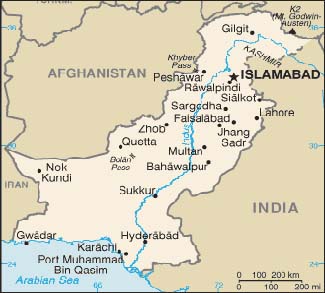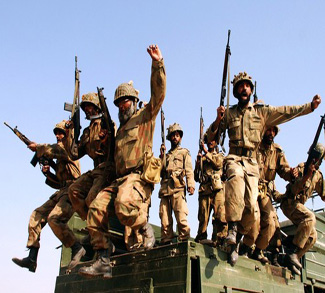The Soviet invasion of Afghanistan in 1979 and the Iranian Islamic Revolution of 1978 helped to re-shape the politics of the Greater Middle East. The latter created the concept of Shi’a political Islam, both within Iran and other parts of the Mideast with significant Shi’a population. In the meantime, the occupation of Afghanistan by the Red Army resulted in the emergence of political Wahhabi Sunni jihadists – backed by the Central Intelligence Agency and Saudi Arabia, coordinated by the Inter-Services Intelligence of Pakistan. In a sense, these two political events lead to the rebirth of the centuries-old Shia-Sunni conflict, and they also reinvigorated Sunni political Islam, or pan-Islamism ideologies in the Muslim world. Iran has become the base for Shia political Islam and the Sunnis wanted to defeat the Soviet Army in Afghanistan in order to establish a base for Sunni political Islam in Afghanistan. This Wahhabi/Sunni dream became truth with the emergence of the Taliban movement from 1994 to 2001. However, The NATO-led invasion of Afghanistan in 2001, with the assistance of the Northern Alliance, has ended the dream – at least for now.
Without regard to what happens in the near future in Afghan politics, the government of Pakistan, with the help of the Inter-Services Intelligence (ISI), is committed to dominating Afghan politics and shaping it in a way that favors Pakistani interests. For instance, the Peshawar Seven formed in 1985 with the assistance of ISI and Saudi Arabia aimed to promote Islamist fundamentalism in Afghanistan. This Peshawar Seven is a group of political parties within Afghanistan, all of which report back to ISI and seek its financial and military assistance. It is important to understand that Pakistan was created in 1947 on the basis of Islam and not ethnicity. Thus, promoting Islamist ideology in neighboring Afghanistan will balance the power of its long-term rival, India and also allow Pakistan to remain stable. Pakistan also has a large Pashtun ethnic group and maintaining Afghanistan under a Pashtun leadership will deter nationalism sentiment among the Pakistani Pashtuns. Pakistan’s involvement in Afghanistan aimed to create a safer border between both states and to integrate Pakistani Pashtuns in the Pakistani government. In other words, Pakistan sought to diminish Pashtun nationalism within Pakistan by giving them more political power in the Pakistani government and higher governmental positions.
Pakistan’s interests in Afghanistan:
1. Limit and lessen India’s sphere of influence in Kabul.
2. Keep India from establishing a closer relationship with Afghanistan, which could in the long run encircle Pakistan and weaken the Pakistani central government in Islamabad.
3. Promote and finance the Haqqani network and Taliban insurgents in Afghanistan to conduct attacks on Indian interests in Kabul. For instance, the Indian embassy in Kabul was attacked twice in 2008 and 2009 and the ISI was rumored to be behind the attacks.
4. Prevent Pashtun nationalism in Afghanistan, which could endanger Pakistani territorial integrity by promoting Pakistani disintegration along ethnic lines. For instance, a strong Afghan government under Pashtun leadership can re-claim the Durand line.
5. Establish economic relations with the oil-rich states of Central Asia by financing a government in Kabul that favors Pakistani interests.
6. Contain the neighboring states from projecting their sphere of influence into Afghanistan.
7. Make sure Pakistan plays an important role in the Afghan peace process, particularly in any post-2014 negotiations with the Taliban. For instance, Pakistan supported the idea of creating a Taliban office in Qatar, Doha in-order to maintain the presence of Taliban in Afghan politics after the NATO withdrawal.
India’s Perspective
The Indian government has been quite supportive of the NATO-led ISAF mission in Afghanistan, as foreign troops saved the country from becoming a safe haven for terror groups led by Islamabad against New Delhi. India seeks to work closely with its Afghan counterparts in reconstruction and economic development projects across the country. India wants Afghanistan to become economically prosperous and capable of limiting Pakistani influence in Afghan domestic affairs. It also wants to prevent the country from becoming a safe haven for Al-Qaeda and the Taliban once again. In October 2011, the Indian government signed a Strategic Partnership with the Afghan government. India agreed to train the Afghan National Army and Afghan National Police, invest massively in Afghan mining, energy, communications, and transportation sectors and provide an additional aid package of $500 million in reconstruction and development projects. India is an emerging economy along with the rest of the BRICS states; thus India needs to extract Afghan natural, mineral, and energy resources in order to drive its economic growth.
India’s interests in Afghanistan:
1. Keep Afghanistan from being used as a base for Pakistan to train and coordinate terror attacks against Indian cities.
2. Weaken and limit Pakistani and Taliban/Pashtun influence over Afghan politics.
3. Establish a network to access oil-rich regions of Central Asia via Afghanistan for pipeline projects and assure energy security.
4. India is seeking great power status, thus the Indian government should foster its sphere of influence across South Asia to promote regional stability.
5. Maintain a certain level of political influence in Afghan politics.
6. Deliver financial aid in order to maintain some sort of economic influence over the Afghan economy.
Future Outlook
With the recent formation of the National Unity government in Kabul and the ratification of the Bilateral Security Agreement with the United States, Afghanistan seems to be falling under the Indian sphere of influence. On November 23 2014, The Lower House of Afghan Parliament, “Wolesi Jirga” approved the Bilateral Security Agreement (BSA) with the United States and the Statues of Forces Agreement (SOFA) with NATO. Last weekend, the Obama administration has signed a classified agreement to extend U.S combat role in Afghanistan. This secret authorization will allow US forces to engage in direct combat against the Taliban, the Haqqani networks, and Al-Qaeda post-2014. This new decision does not respect the previous agreement by the Obama Administration, in which he promised to end the US combat role in Afghanistan. These new developments in Afghanistan are certainly helping India to promote its geopolitical interests and also consolidate its diplomatic mission across Afghanistan to further destabilize and limit the influence of Pakistan over Afghan politics. India has built an embassy in Kabul, along with four consulates in Kandahar, Jalalabad, Mazar-e-Sharif, and Herat. India’s main foreign intelligence agency, Research and Analysis Wing (RAW) is becoming quite active inside Afghanistan with the collaboration of the Afghan secret service, Riyasat-e-Amniyat-e-Milli (RAM) and Afghanistan’s domestic intelligence agency, The National Directorate of Security (NDS).
The current president is a Pashtun, Dr. Ashraf Ghani, First Vice President, General Dostum an ethnic Uzbek and Second Vice President, Mr. Sarwar Danish an ethnic Hazara. Also, Mr. Abdullah Abdullah an ethnic Tajik is the Chief Executive Officer in this National Unity Government. This means that that era of Pashtun domination over the government is over, and Pakistan is less able to instigate ethnic unrest in Afghanistan. In addition, the ratifications of the BSA and SOFA along with the Strategic Partnership with India, Indian geopolitical interests will advance quickly in Afghanistan. In other words, the current political environment in Kabul favors Indian geopolitical interests over those of Pakistan. The upcoming London Conference on Afghanistan, organized by the British and Afghan governments, which will be held on December 4 2014 will discuss further Afghanistan’s future and International Community’s commitment for state-building.




